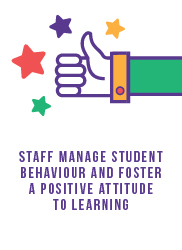Behaviour for Learning: De-escalation

When confronted with aggressive behaviour the first thing to try is to reduce any aggression and try and calm the student down. The following things can make a difference to the student’s behaviour:
- Using their name (status/rapport)
- Acknowledging their right to their feelings (fairness/status)
- Telling them why you are there (rapport/status)
- Telling them what they can do (autonomy/certainty)
- Offering a “get out” (status/autonomy)
For example: Mo, I can see something has happened and I am here to help. Talk to me and I will listen. You can choose to come with me and........or.... I need you to…
Before any situation escalates the student will have built themselves up into a state of anger. They then reach the peak of their anger and then gradually begin to calm down. This is called the Aggression Curve:

Although an educational setting is a learning environment, the brain experiences this environment first and foremost as a social system. For example, when an action triggers a threat response brains become much less efficient. knowing the drivers that can cause a threat response enables people to design interactions to minimise threats.
We hope that these simple five steps will help should you need to de-escalate a situation. If you’d like any further training or practise, we would be happy to organise this with you.
Please get in touch with either of us if you’d like us to drop in to a particular class or student that’s causing you concern or if you’d like to meet to brainstorm strategies to use with particular groups. If you’d like some behaviour for learning coaching or to develop CPD for your department, we’re here to support.
Our Wednesday lunchtime behaviour for learning will be running this week; please come along.
We hope you have a great week.
Mark and Jo